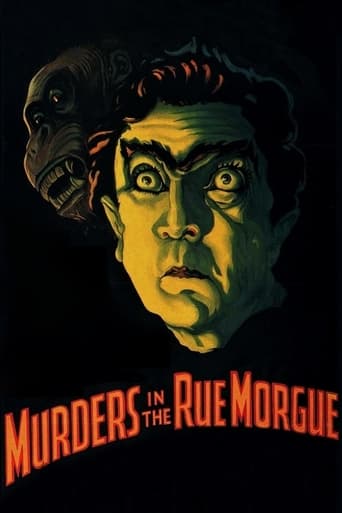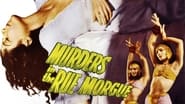alexanderdavies-99382
"Murders in the Rue Morgue" has been rather unfairly regarded over the years. It's actually quite difficult to judge this film as 15 minutes of footage was removed before the film went out on general release in 1932.Bela Lugosi steals the film as the crazed scientist. The supporting cast ranges from being tolerable to downright poor.Director Robert Florey was offered "Murders in the Rue Morgue" as a consolation prize after being removed from the 1931 "Frankenstein" movie.According to various sources, "Murders in the Rue Morgue" didn't satisfy Florey half as much as "Frankenstein" would have. Be that as it may, the above film has many effective scenes and is quite violent for 1932. The photography is outstanding as the cameras roam along the streets that represent 1840s Paris. The atmosphere is well sustained throughout. The comedy interludes are CRINGEWORTHY though. There is simply no place for it in this film. However, the damage is minimal.The film works itself to a thrilling climax.
Leofwine_draca
Fun, if minor, Universal horror flick which casts Bela Lugosi in his trademark role as a screen icon of pure evil. This is a very loose adaptation of the Edgar Allan Poe story; the locked-room murder does occur towards the end of the movie, complete with a body stuffed in a chimney, but this is only part of it. Instead, MURDERS IN THE RUE MORGUE focuses on Lugosi's mad scientist and his Darwinian theories that humans are descended from apes (the setting being Paris in 1845, this idea is widely pooh-poohed). In order to prove this, he attempts to mate a girl with an ape, and his plan involves injecting girls with gorilla blood which results in a series of strange deaths. Lugosi ingeniously dumps the bodies into the river under his house and the victims are simply described as victims of drowning.Of course it's not long before an irritating medical student is on the case to foil Lugosi's plans, but he's interrupted in his task when the ape goes berserk and murders Lugosi itself. This leads to an exciting rooftop finale which acts as a miniature forerunner to KING KONG with the ape kidnapping the young female victim and escaping from roof to roof as her suitor gives chase. A well-placed bullet sends the ape to a watery grave, thus ending the film at the incredibly short hour mark. MURDERS IN THE RUE MORGUE is an understandably dated film with many aspects to alienate it to modern audiences. Like Dracula, there's no music in any scenes which make it look more like a stage play than a movie. The special effects involve closeups of a cute chimpanzee interspersed with a clumsy man in a poor costume pretending to be an ape and are extremely poor in the modern light.However, all is not lost. As mentioned on the back of the box, the film does recall the classic German Expressionist movies in the use of lighting and shadows, and strange backdrops which really help to give it a unique look. There's a fair amount of brooding atmosphere built up in the backstreets of a dirty Paris and plenty of ghoulish humour in the morgue (as well as some unwanted over-the-top comedy and acting at a police inquest). The film also benefits considerably from one of Lugosi's best roles as a crazed, demented scientist who talks to his pet ape and shocks people at a carnival with his insane evolutionary theories (the irony being, of course, that he was correct in his assumptions). Lugoi's wild-haired mad man gets to wear some great costumes which emphasis his skeletal body and delivers his lines with an evil relish. The same quality cannot be said of the rest of the cast, especially the boring hero and his policemen chums, whom we have no interest in whatsoever. Thankfully Sidney Fox makes for quite a fetching beauty and can scream with the best of them. MURDERS IN THE RUE MORGUE isn't one of Universal's best movies, but it remains a solid (if dated) piece of entertainment with much to commend it to classic horror fans.
mark.waltz
The horror for a young girl held prisoner by a mad scientist today would be that she wouldn't have a cell phone in her hand, but in the case of the poor prostitute here (Arlene Francis), you really feel fear for her. She's first seen screaming as two drunken men fight over her, and all of a sudden Bela Lugosi is approaching her, a nefarious close-up dominating his saunter towards her. The next thing you see is her being held hostage, tied to a cross, screaming in horror. The chills aren't only on her body, but in the viewers as well, as the photography and tense music and editing make the horror all the more real. Lugosi is determined to prove the connection between man and ape, and he is first seen explaining that to an audience which includes the heroine (Sidney Fox). "Your blood is rotten!" Lugosi screams at the poor unfortunate street walker, but he had originally set his sights on Fox and has his man- servant locate her so he can have his gorilla kidnap her for more nefarious experimentation.In a very short running time, the Universal horror classic really makes an impression, and even with his Chico Marxx like hairdo, Lugosi is absolutely frightening. Who'd think that an early 30's horror film without blood, throat slashing and body parts being ripped off could be so frightening? Of course, the music of "Swan Lake" is heard in the background as it was for all of the early Universal horror films, and in playing it rather slowly makes it all the more haunting. The photography resembles the silent German expressionism of films like "The Cabinet of Dr. Caligari" and "Nosferatu" and in a way, this makes it even spookier than "Dracula" and "Frankenstein". A re-make in 3-D pales in comparison to this.
Prichards12345
The third entry in Universal's horror cannon is one of their weakest efforts from the golden age. After the gigantic success of Dracula and Frankenstein the studio produced the first of their Poe adaptations. Budget was a major concern, and the use of a public domain author initially saved money. Unfortunately a whole batch of writers (including a young John Huston) worked on the script, and the patchy and messy result turned contemporary audiences off. Director Robert Florey, having been bumped from Frankenstein, was able to get the budget increased to around $190,000. But it was hardly worth the effort.Bela Lugosi, whom the studio considered as the new Lon Chaney for a brief period, plays Dr. Mirakle, early proponent of Darwinism. Operating from a carnival in mid-nineteenth century Paris, he tries to prove man's kinship with the ape by injecting the blood of a gorilla into the street walkers he picks up. The film was to have opened with Lugosi rescuing a prostitute from a knife fight, and then conducting his experiment at his hideout with his victim tied to a gigantic crossbeam and screaming the place down, before dying. However Universal moved this scene to just after the opening we now have, and instead we get a staid lecture from Mirakle on his theory to carnival gawkers. However the theory of evolution was still controversial in 1932 - it had only been a decade since the infamous Scopes monkey trial, and one wishes the movie would have concentrated a little more on this element.Poe's detective Auguste Dupin here becomes a medical student, with his shrill beau Camille(Sidney Fox) and very sissy room-mate Paul (Bert Roach) they are about as far from Poe as you can get. Roach in particular attempts a brand of comedy that has dated badly - even audiences of the time probably cringed. And much of the film is taken up with Mirakle's attempt to lure Camille into his clutches - he's convinced her blood will be perfect. Leon Ames is probably the worst Dupin ever to appear on film, from foolish love talk to histrionic bad acting in 60 minutes. What Mirakle sees in Camille is anybody's guess; she's a very unappealing heroine and we don't care at all as to her eventual fate. Fox is as bad as Aimes.Only Lugosi stands out in this film, and even so this isn't one of his best performances. He tries but fails to inject some mystery into the proceedings; director Florey doesn't help with his pointlessly expressionistic approach. He was aiming for Caligari but the shots of the ape yawning, and mismatched with Charles Gemora in an ape suit, draw some unintentional laughs.So apart from the strong streetwalker scene and some atmospheric touches, you really have to wait for the final fifteen minutes for some excitement. At an hour in length, at least you don't have to wait too long. Universal's next Poe outing,The Black Cat, would be far superior.





